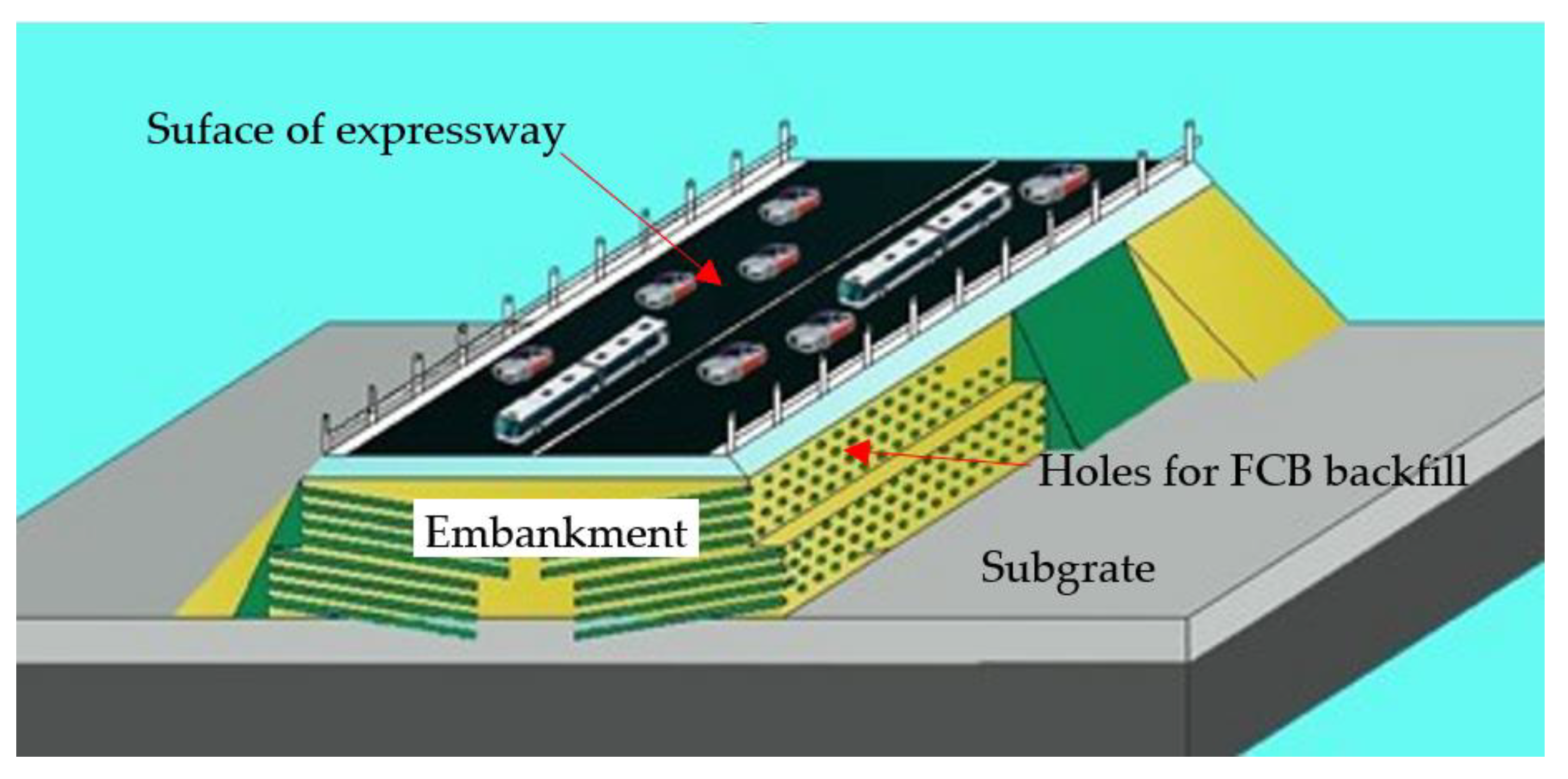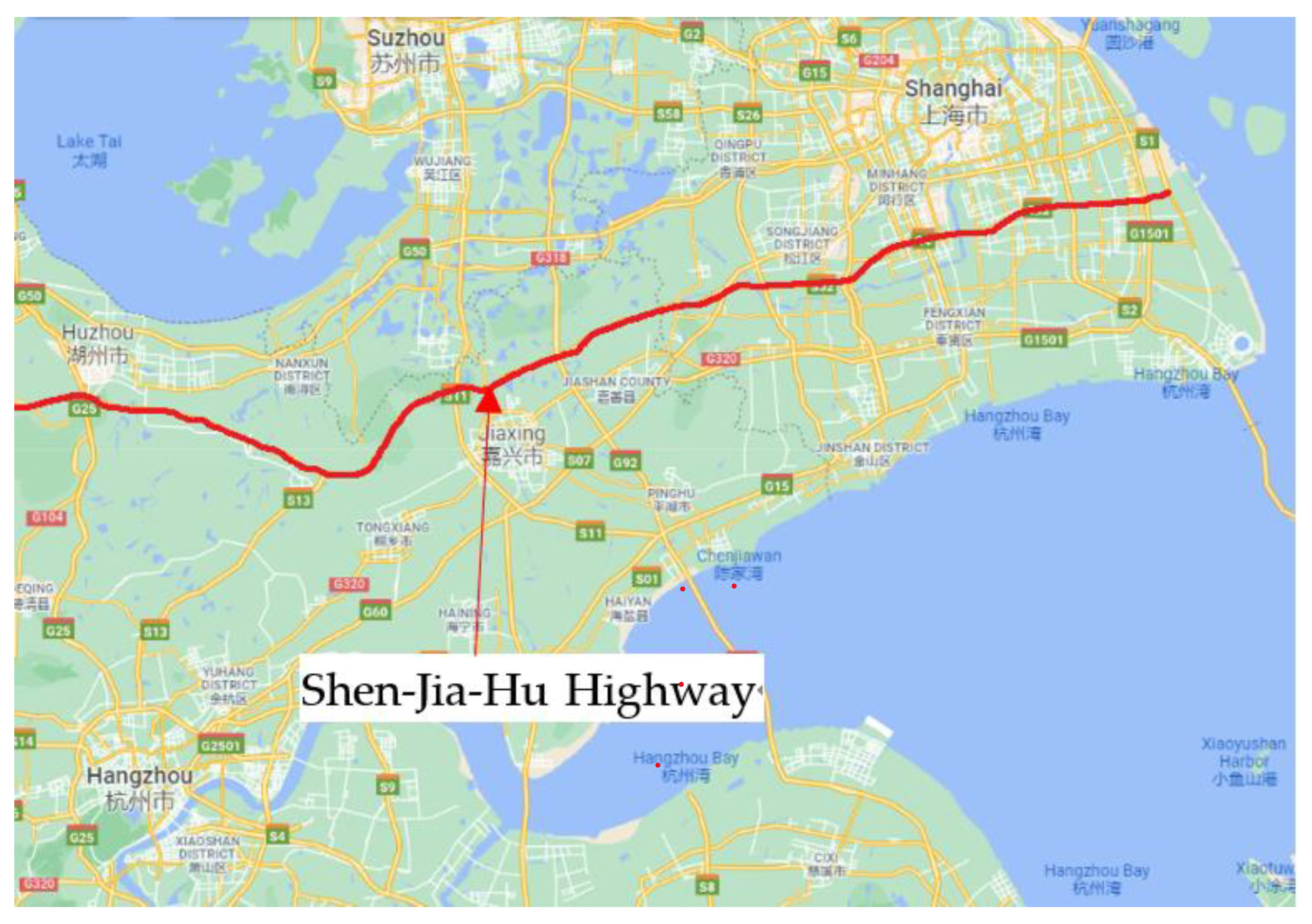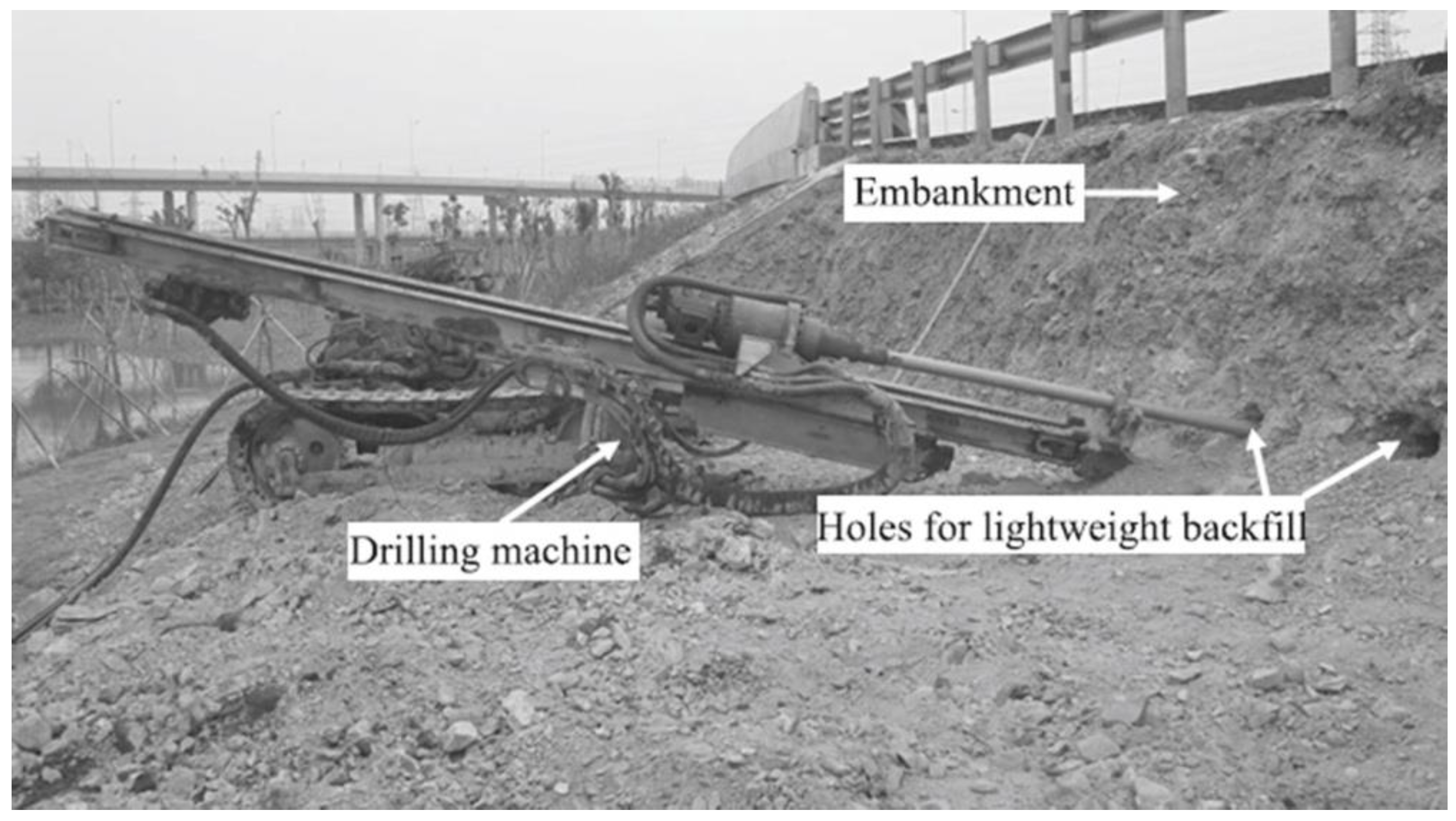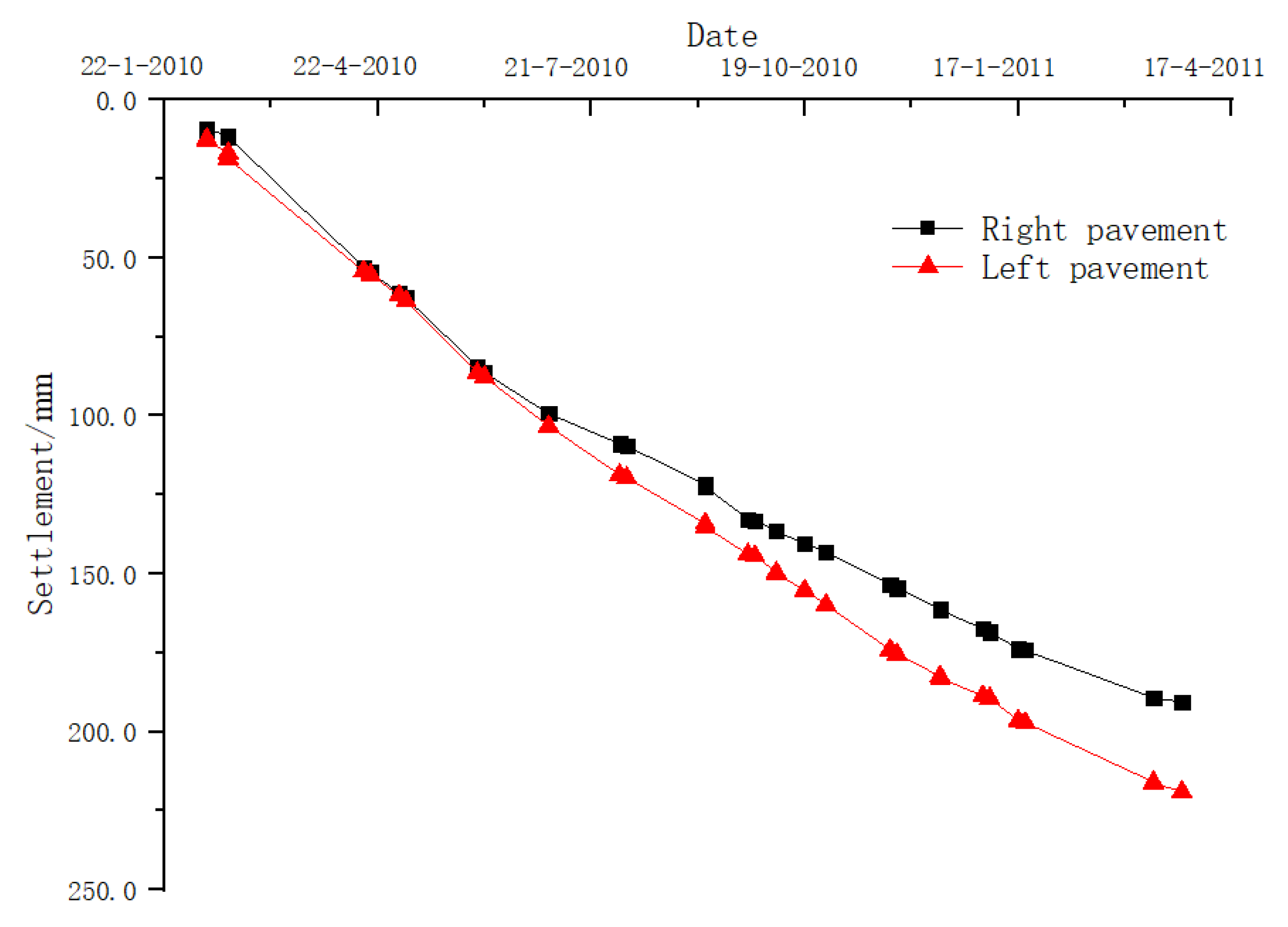Use of Foamed Cement Banking for Reducing Expressways Embankment Settlement
Abstract
:1. Introduction
2. Design Principles and Calculation Method
2.1. Principle of FCB
2.2. Calculation Method
3. Field Study on Shen-Jia-Hu Highway
3.1. Engineering Situation
3.2. Construction Process
3.3. Improvement before Analysis of Monitoring Data
3.4. Effectiveness Analysis of Improvement
4. Discussion
5. Conclusions
- (1)
- The FCB method is an effective means to reduce highway embankment differential settlement without disturbing normal traffic, which has the following advantages: (1) convenience for continued highway operation, (2) high flexibility, and (3) an ideal improvement effect.
- (2)
- Based on the proportional relationship between unloading amount and settlement value, a calculation method for unloading amount determination was developed herein. This method was used to determine the amount of embankment replacement and apply it to actual projects, which was then verified to be practical and accurate.
- (3)
- According to the theoretical settlement value predicted in the previous article, and from the analysis of field monitoring data from practical highway projects, the pavement monthly settlement ratio was theoretically reduced by 50% and the residual post-construction settlement by 60% when transverse drilling and FCB improvement were completed. Therefore, in practice, FCB improvement is an effective means to control and reduce embankment differential settlement.
Author Contributions
Funding
Institutional Review Board Statement
Informed Consent Statement
Data Availability Statement
Conflicts of Interest
References
- Wang, Y.S. Settlement of soft soil foundation of Expressway. China J. Highw. Transp. 1993, 6, 61–66. [Google Scholar]
- Zhou, S.; Wang, B.L.; Shan, Y. Review of research on high-speed railway subgrade settlement in soft soil area. Railw. Eng. Sci. 2020, 28, 129–145. [Google Scholar] [CrossRef]
- CCCC Second Highway Survey and Design Institute. Specifications for Design of Highway Subgrades; China Communications Press: Beijing, China, 2015; pp. 69–70, 84–85. [Google Scholar]
- Li, J.; He, D.P.; Peng, Y.H. Alleviating bump at bridge-head using geocell flexible approach slab. In Proceedings of the Third International Conference on Transportation Engineering, Chengdu, China, 23–25 July 2011; ASCE: Reston, VA, USA, 2011; pp. 1609–1617. [Google Scholar]
- Pan, X.D.; Du, Z.G.; Yang, X.G. Evaluation indexes of the impact of vehicle bumping at bridge-head on driving safety. J. Tongji Univ. Nat. Sci. 2006, 34, 634–637. [Google Scholar]
- Zhao, X.X.; Yang, L.J. Analysis and management methods for the road and bridge transition’s sedimentation on the soft clay ground in Shanghai. J. Lanzhou Jiaotong Univ. 2008, 27, 37–40. [Google Scholar]
- Lu, T.; Yang, P.; Li, M.X.; Yi, L.H. Analysis of deformation behavior of foamed lightweight soil subgrade on soft soil foundation. Subgrade Eng. 2018, 46, 38–41. [Google Scholar]
- Liu, H.L.; Yi, F.; Chen, Y.H. Study on method of laterally replacing subgrade of existing expressway by light soil. J. Highw. Transp. Res. Dev. 2019, 36, 19–27. [Google Scholar]
- Huang, T.Y.; Wang, X.Q.; Fang, G.W.; Zhang, H.P.; Diao, H.G. Design and calculation methods of light soil replacement after preloading in the soft soil foundation of the highway. Urban Rapid Rail Transit 2019, 37, 59–63. [Google Scholar]
- Jones, M.R.; McCarthy, A. Utilizing unprocessed low-lime coal fly ash in foamed concrete. Fuel 2005, 84, 1398–1409. [Google Scholar] [CrossRef]
- Wang, Z.J.; Sun, Z.C.; Lu, L.; Li, J.B. Study on the uniaxial compressive mechanical properties of foamed mixture lightweight soil with polypropylene fibers. Chin. J. Undergr. Space Eng. 2018, 16, 1021–1029. [Google Scholar]
- Li, Y.Z. Foamed cement banking for reinforcing soft ground. Miner. Explor. 2008, 11, 66–68. [Google Scholar]
- Gao, Y.L.; Xiao, M.Q.; Guan, H.X. Foamed cement banking and its utilization in highway engineering. Bull. Chin. Silic. Soc. 2016, 35, 2432–2438. [Google Scholar]
- Deng, H.W. Bubble-mixed light soil applied in a metro high-fill roadbed. Urban Rapid Rail Transit 2018, 31, 88–91. [Google Scholar]
- Ding, X.H. Study on design and calculation of foamed cement banking. Subgrade Eng. 2017, 35, 146–151. [Google Scholar]
- Jamnongpipatkul, P.; Dechasakulsom, M.; Sukolrat, J. Application of air foam stabilized soil for bridge-embankment transition zone in Thailand. In Proceedings of the American Society of Civil Engineers GeoHunan International Conference, Changsha, China, 3–6 August 2009; ASCE: Reston, VA, USA, 2009; pp. 181–193. [Google Scholar]
- Xiao, L.J. Foamed Cement Banking and Applications in Highway Construction. Master’s Thesis, Hunan University, Changsha, China, 2003. [Google Scholar]
- Wu, Y.D.; Liu, J. Research on foamed cement banking for non-uniform differential settlement in used super highway. In Proceedings of the International Conference on Electric Technology and Civil Engineering, Lushan, China, 22–24 April 2011; IEEE: Washington, DC, USA, 2011; pp. 5334–5337. [Google Scholar]
- Chen, Y.H.; Shi, G.C.; Cao, D.H.; Ying, H.J.; Wang, X.Q. Control of post-construction settlement by replacing subgrade with foamed cement banking. Chin. J. Geotech. Eng. 2011, 33, 1854–1862. [Google Scholar]
- Cao, D.H.; Chen, Y.H.; Wang, X.Q.; Sun, H.; Wei, J. A study on dynamic controlling to embankment settlement of Shen-jia-hu-hang expressway. Highway 2010, 55, 45–48. [Google Scholar]
- Nanjing Hydraulic Research Institute. Standard for Geotechnical Testing Method; China Planning Press: Beijing, China, 2019; pp. 16–125. [Google Scholar]





| Material Type | Advantage | Disadvantage |
|---|---|---|
| EPS beads-mixed lightweight soil | Low density and compressibility; high strength; environmental protection. | Difficult construction; high material cost; poor corrosion resistance. |
| EPS block | Low density; stable nature; convenient construction. | High material cost; poor impact resistance; easy to local cavity. |
| Foamed cement banking | Low density; good integration; high strength and corrosion resistance; short construction period. | High cement hydration heat; high material cost. |
| Type of Soil Layer | Thickness (m) | Water Content (%) | Natural Density (g/cm3) | Void Ratio | Compression Modulus (MPa) | Compression Factor (Mpa−1) | Cohesion (kPa) | Internal Friction Angle |
|---|---|---|---|---|---|---|---|---|
| Planting soil | 2.1 | - | - | - | - | - | - | - |
| Silty clay | 1.2 | 22.7 | 1.95 | 0.64 | 7.24 | 0.22 | 45.00 | 15.20 |
| Silt clay | 10.4 | 51.5 | 1.70 | 1.40 | 2.91 | 0.83 | 32.50 | 20.30 |
| Clay | 11.2 | 30.7 | 1.90 | 0.86 | 5.89 | 0.32 | 30.30 | 23.90 |
| Fine sand interlayer | 0.4 | 24.5 | 1.98 | 0.70 | 16.81 | 0.10 | - | - |
| Silty clay | 3.9 | 23.4 | 1.99 | 0.68 | 10.93 | 0.15 | 40.00 | 26.50 |
| Section | Settlement Rate March (mm/month) | Present Settlement (mm) | The Settlement Forecast (mm) | Residual Settlement (mm) | |
|---|---|---|---|---|---|
| EK0 + 323 | left | 9.2 | 189.6 | 292.9 | 103.3 |
| right | 11.2 | 219.3 | 402.2 | 182.9 | |
Publisher’s Note: MDPI stays neutral with regard to jurisdictional claims in published maps and institutional affiliations. |
© 2021 by the authors. Licensee MDPI, Basel, Switzerland. This article is an open access article distributed under the terms and conditions of the Creative Commons Attribution (CC BY) license (https://creativecommons.org/licenses/by/4.0/).
Share and Cite
Wu, Y.; Liu, H.; Liu, J. Use of Foamed Cement Banking for Reducing Expressways Embankment Settlement. Appl. Sci. 2021, 11, 11959. https://doi.org/10.3390/app112411959
Wu Y, Liu H, Liu J. Use of Foamed Cement Banking for Reducing Expressways Embankment Settlement. Applied Sciences. 2021; 11(24):11959. https://doi.org/10.3390/app112411959
Chicago/Turabian StyleWu, Yuedong, Hui Liu, and Jian Liu. 2021. "Use of Foamed Cement Banking for Reducing Expressways Embankment Settlement" Applied Sciences 11, no. 24: 11959. https://doi.org/10.3390/app112411959
APA StyleWu, Y., Liu, H., & Liu, J. (2021). Use of Foamed Cement Banking for Reducing Expressways Embankment Settlement. Applied Sciences, 11(24), 11959. https://doi.org/10.3390/app112411959






